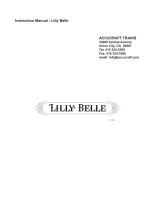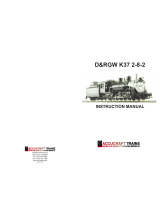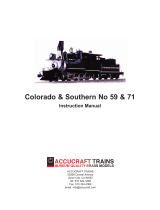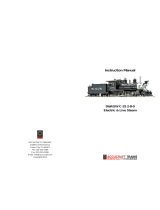Page is loading ...

ACCUCRAFT TRAINS
33268 Central Avenue
Union City, CA 94587
Tel: 510 324-3399
Fax: 510 324-3366
email: [email protected]
INSTRUCTION MANUAL
Instruction Manual - Lilly Belle 1:20.3 Scale, Live Steam

Walt Disney's lifelong passion for railroads started while he was a boy growing up in Missouri.
He and his older brother Roy would often wait for the trains that roared through their home-
town of Marceline. Often, their uncle, Mike Martin, would be at the throttle of the mighty steam
engine and would wave to the boys as he passed. During visits to the family farm, Mike would
entertain the boys with exciting stories of life on the rails, and legendary figures such as Casey
Jones and Buffalo Bill.
Many years later, Walt rekindled his love of trains. In the 1940's, he frequently visited the
backyard railroads of two of his key animators, Ward Kimball and Ollie Johnston. He decided
to construct a home with enough land to allow him to build his own backyard railroad. It was
located in the Holmby Hills area of Los Angeles on Carolwood Drive, and he called his railroad
the Carolwood Pacific.
He decided that the size of his steam engine would be one-eighth of a full-scale locomotive. He
based his engine on the famous Central Pacific 173, which was the first steam engine built in
California. Walt, Roger Broggie and the machinists at the Disney Studios machine shop built
the large-scale miniature. Its first run at Carolwood was in May 1950, and he named it "Lilly
Belle" in honor of his beloved wife, Lillian.
Walt's friends and family enjoyed the Carolwood Pacific for over three years. Walt even started
work on a second engine to handle the many guests that came to Carolwood. Over time, how-
ever, the dangers of running a railroad at his home became troublesome for him. He shut down
the Carolwood Pacific and set his sights on a new goal: a wondrous park where families could
play together. His first description of this magical place was, "I just want it to look like nothing
else in the world... and it should be surrounded by a train." This vision would become the place
we all know as Disneyland.
In 1993, Michael Broggie, son of Roger and author of "Walt Disney's Railroad Story", founded
the Carolwood Pacific Historical Society. We are dedicated to preserving and promoting Walt
Disney's rich railroad legacy. Among our activities are the care of Walt's Carolwood barn (now
located in Griffith Park), the restoration of Walt Disney World's Fort Wilderness railroad, and
products such as this recreation of Walt's Lilly Belle. You may learn more about us at www.
carolwood.com. We hope that you will consider joining our Society.
Page 1
Instruction Manual - Lilly Belle 1:20.3 Scale, Live Steam
The Carolwood Pacific Railroad - A Brief History

The 4-4-0 was a small sized inside frame
locomotive that worked all over North and
South America. They were Built in the
1870's and 1880's. The 4-4-0 shared many
common parts with other similar sized loco-
motives of the same period. The three point
suspension allowed these engines to go over
fairly rough track without derailing, and also
because of their large drivers move along
at a good speed with a passenger train on
level track. The classic 4-4-0 or American
is the lovomotive that most people think of
when the old west was young. Hollywood
correctly uses these preserved locomotives
even today when needing trains of that
period.
Page 2
Instruction Manual - Lilly Belle 1:20.3 Scale, Live Steam
OPERATING INSTRUCTIONS
INTRODUCTION: SAFETY FIRST:
All our locomotives are safe to run, and will
give many hours of pleasure, provding the
following safety procedures are followed:
1. Please read the instructions thoroughly
before running for the first time.
2. Always do a complete refill of gas, oil
and water. Never refill just the gas to
prolong the run.
3. Never let the engine run out of water.
4. When refilling the gas, do not have any
naked flame present, and NO SMOKING!
5. Do not pick up the engine by the body
work,chimney or boiler, especially when
hot.
6. Only pick up the engine by the buffer
beams and, when hot, use gloves or
cloth.
7. Do not stand over the chimney. Ejected
boiling water or steam may cause seri
ous injury.

Page 3
Instruction Manual - Lilly Belle 1:20.3 Scale, Live Steam
GENERAL HINTS:
Keep the engine as clean as possible, and the
motive free from dirt and garden debris, the valve
gear, axles and crank pins should be oiled spar-
ingly with light oil, e.g. "3-in-1 oil." Over-oiling
attracts dirt and grit, which will increase wear.
Regularly check that all screws and motion-
bolts are firm. Do not over tighten, as the strips
threads and shears bolts, When filling the
lubricator, always use high temperature
superheat steam oil, suitable for locos fitted
with super heaters; this is available from
garden railway product retailers. FAILURE
TO USE THE CORRECT GRADE OF OIL
CAN LEAD TO BLOCKED STEAM PIPES,
AND WILL INVALIDATE THE GUARANTEE.
When running your engine, avoid exces-
sive speed and acceleration, both will
cause premature wear in the valve gear.
Prototypically, narrow gauge locomo-
tives ran at a speed of between 20 and 40
m.p.h. and never should exceed 45 m.p.h.
END OF RUN:
As previously mentioned, the locomotive will
slow (due to pressure dropping) when the fire
has gone out. Stop at a convenient place and
open the lubricator drain valve. Blow out tall
condensed water and the remaining oil. Leave
the drain open allow all the remaining steam oil
blow out. The locomotive should be allowed to
cool. When cool, clean the engine, check the
motion and oil if necessary. The locomotives
should always be put away in a clean condition,
as it attracts less dust and is always ready for
the next run (or to be shown to an admiring
friend). It is advisable to store the loco where
any residual drips of oil or water do not matter.
BLOCK GAS JETS:
If the gas jet becomes blocked with particles of
dirt within the gas, the jet will have to be removed
and cleaned. Using a spanner carefully.
Remove the jet holder assembly from the
burner. Holding the jet holder, gently, unscrew
the jet. To clear, place the jet nozzle against the
inverted gas can nozzle and clear the jet with
a blast of gas. Under no circumstances use a
wire, this will damage the jete hole. Replace the
jet in the holder, ideally using a thread sealant
sparingly on the threades. Ensure it tightened
up firmly. Replace the assembly into the burner.

Page 4
PREPARATION FOR RUNNING:
Always service the engine in th following
order; gas, oil then water.
To fill the gas tank: invert the gas can and
apply the nipple to the gas inlet valve on the
top of the tank turret. You will know when
the tank is full; gas will blow back from the
inlet valve in a strong jet. A small amount of
gas and air will escape during filling, but the
difference between this and when the tank
is full is always clear. Always keep the gas
can valve vertical when filling the gas tank.
To fill the lubricator: as you will read in the
instructions for the "end of the run", the lubricator
should be empty of oil and water with the valve
and remove the filler cap. Fill-up the lubricator
with steam oil to about a 1/4 inch below the
top. Leave the filler cap off fro the present, so
that any trapped air can escape. Remeber to
refit the cap after you have filled the boiler.
To fill the boiler: remove the filler cap. Fill
the boiler completely - ideally using distilled.
When the boiler is full of water, pull out 30
ml of water using the large syprings. This
will allow space in the top of boiler filler
cap. Filler caps should be firm finger tight.
They are sealed with a trapped "O" ring
and, therefore should not be over-tightened.
LIGHTING UP:
Open the smoke box door; just pull it open by
the door handle. Light your lighter/match etc.,
and gently open the gas control valve until a
gentle hiss is heard in the burner. Apply your
light in to the smoke box and the glame should
'pop' down the fire tube and ignite the burner
inside the fire tube. If the gas vlave is opened
too much the flame will not pop back; it will either
fail to ignite, will roar in flame out of the somke
box, or there will be a ball of flamearound the
front of the engine, which will then blow the
whole fire out (After giving the drivera fright)!
When the fire sound has stabilized, after
about 30 seconds the gas can be turned up
until a healthy roar is heard. The smokebox
door may be shut after about two minutes.
Now leave the locomotive to raise steam.
Instruction Manual - Lilly Belle 1:20.3 Scale, Live Steam

Page 5
RUNNING:
When the engine has raised about 40 psi, you
are ready to start running, It is advisable to
run the engine in reverse fi rst; It clears the
condensed water from the cylinders best this
way. Before commencing your fi rst run of the
day, it is advisable to put a cloth loosely over
the chimmey for a few minutes, as condensed
water will be ejected from the cimney. This is
quite normal; the motion of the engine will be
jerky until all condensate has been ejected. DO
NOT stand over the chimmey as ejected boiling
water/steam could cause serious scalding.
Place the direction lever into the reverse
position, and then open the main steam
valve. The engine should start to move off
in the reverse direction . When starting from
cold it will be jerky, this is normal, as it has
to clear the condensate from the system. The
more the main steam valve is opened, the
faster the engine will go; our advice is to start
slowly and learn the road with your engine.
After a minute or so, remove the clothe and
continues running. In running it is correct
practive to blance the boiler pressure against
the load being pulled and the track conditions.
With a light load and level track the pressure
may need to be only 25~30 p.s.i. Therefore,
turn the gas control down to keep this pressure.
When running a havey train with steep
gradients, increase the pressure can be leant
be experience and is onf=e of the pleasures of
running a live steam engine. There is no need
to have the safety vlave constantly blowing off
(it is what its name implies - a safety vent for
excess steam pressure). In all our designs,
the gas has been programmed to run out just
before the water, thus it is important not to
refill with gas alone in order to lengthen the
run by a few minutes. When the gas runs out
a complete gas, oil and water service must be
done (remeber GOW, also remember to shut
the gas regulator before refilling, and DO NOT
refill with gas near any other live steam loco).
When locomotive slows as the pressure falls at
the end of a run, stop the engine. Gently open
the lubricator valve and blow out any condensed
water. If you intend to continue running, close
the drain when you see oil coming out of it
and carry out a general refill. If it is the last
run of the day, leave the lubricator drain valve
open and blow the lubricator completely clean.
Instruction Manual - Lilly Belle 1:20.3 Scale, Live Steam

Page 6
POSITIONS OF FILLERS AND DRAINS
ETC.:
The cab roof tilts up to give access to all fillers.
The gas tank is in the tender. Once the
tank is charged you must put a water bath
around the tank to keep the tank from
freezing. It keeps the gas pressure up!
The lubricator is in the left rear corner of
the cab. The lubricator drain is directly
beneath the lubricator. To drin, un-screw
the drain valve through about 1/2 a trun.
The boiler water filler is on the top of the
steam turret on the boiler in the middle of the
cab. Undo the knurled cap to fill with water.
The main steam regulator valve is the wheel
valve on the rear of the boiler-filling turret.
The direction control is lever in the right
side cab door. To operate, pull gently out-
wards and move to the desired direction.
The control is "gated", and will therefore hold
itself in the full forward or reverse position.
Instruction Manual - Lilly Belle 1:20.3 Scale, Live Steam

3. The locomotive is firmly taped to a 1/2”
wood board which is then fastened to the
metal case with 4 M6 bolts. Bolts must be
removed before lifting the locomotive with
wood board from the metal case.
4. Place taped locomotive on a flat surface.
Carefully cut the tape along the wood board
side surface. Be sure to cut both sides of
the wood board. Slowly lift the tape from the
locomotive. Be very careful with small parts.
Tape cannot be re-used to re-pack the model.
Use new packing tape if necessary.
Unpacking Lilly Belle
Accucraft Trains locomotives are fine scale
brass models with small parts. To provide
maximum protection from shipping damage,
we carefully pack the models in metal cases.
We ship via UPS with insurance coverage to
its full value. Please contact UPS if package
is damaged.
Each locomotive is packed under UPS guide-
line for shipping. We do not warrant any dam-
age resulted from re-packaging by any party
other than Accucraft Trains.
Please read the following directions before
unpacking your locomotive.
1. Remove foam around the locomotive.
Slide the inner box cover to the side, and
open the inside cardboard box with a cutting
knife.
2. Lift the metal case from the cardboard
box.
Page 7
Instruction Manual - Lilly Belle 1:20.3 Scale, Live Steam
Please register your product at www.accucraft.com
For technical support, please call 510-324-3399
/
















